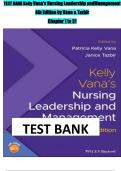TEST BANK Kelly Vana's Nursing Leadership andManagement
4th Edition by Vana & Tazbir
Chapter 1 to 31
TEST BANK
,6
Table6of6Contents:
Unit6I:6NURSING6LEADERSHIP6AND6MANAGEMENT.
Chapter61.6Nursing6Leadership6and6Management.
Chapter62.6The6Healthcare6Environment.
Chapter63.6Organizational6Behavior6and6Magnet6Hospitals.
Chapter64.6Basic6Clinical6Healthcare6Economics.
Chapter65.6Evidence-Based6Health6Care.
Chapter66.6Nursing6and6Healthcare6Informatics.
Chapter67.6Population6Based6Healthcare6Practice.
Unit6II:6LEADERSHIP6AND6MANAGEMENT6OF6THE6INTERDISCIPLINARY6TEAM.
Chapter68.6Personal6and6Interdisciplinary6Communication.
Chapter69.6Politics6and6Consumer6Partnerships.
Chapter610.6Strategic6Planning6and6organizing6Patient6Care.
Chapter611.6Effective6Team6Building.
Chapter612.6Power.
Chapter613.6Change,6Innovation,6and6Conflict6Management.
Unit6III:6LEADERSHIP6AND6MANAGEMENT6OF6PATIENT-6CENTERED6CARE.
Chapter614.6Budget6Concepts6for6Patient6Care.
Chapter615.6Effective6Staffing.
Chapter616.6Delegation6of6Patient6Care.
Chapter617.6Organization6of6Patient6Care6Management.
Chapter618.6Time6Management6and6Setting6Patient6Care6Priorities.
Chapter619.6Patient6and6Health6Care6Education.
Unit6IV:6QUALITY6IMPROVEMENT6OF6PATIENT6OUTCOMES.
Chapter620.6Managing6Outcomes6Using6an6Organizational6Quality6Improvement6Model.
Chapter621.6Evidence6Based6Strategies6to6Improve6Patient6Care6Outcomes.
Chapter622.6Decision6Making6and6Critical6Thinking.
Chapter623.6Legal6Aspects6of6Health6Care.
Chapter624.6Ethical6Aspects6of6Health6Care.
Chapter625.6Culture,6Generational6Differences,6and6Spirituality.
Unit6V:6LEADERSHIP6AND6MANAGEMENT6OF6SELF6AND6THE6FUTURE.
Chapter626.6Collective6Bargaining.
Chapter627.6Career6Planning.
Chapter628.6Nursing6Job6Opportunities.
Chapter629.6Your6First6Job.
Chapter630.6Healthy6Living:6Balancing6Personal6and6Professional6Needs.
Chapter631.6NCLEX6Preparation6and6Professionalism
.
,6
Chapter61:6Nursing6Leadership6and6Management
MULTIPLE6CHOICE
1 .6According6to6Henri6Fayol,6the6functions6of6planning,6organizing,6coordinating,6and6controlling
are6considered6which6aspect6of6management?
a.6 Roles
b.6 Process
c.6 Functions
d.6 Taxonomy
ANS:6B,6The6management6process6includes6planning,6organizing,6coordinating,6and6controlling.6Management6roles6include
information6processing,6interpersonal6relationships,6and6decision6making.6Management6functions6include6planning,6organizing,
staffing,6directing,6coordinating,6reporting,6and6budgeting.6A6taxonomy6is6a6system6that6orders6principles6into6a6grouping6or
classification.
2 .6Which6of6the6following6is6considered6a6decisional6managerial6role?
a.6 Disseminator
b.6 Figurehead
c.6 Leader
d.6 Entrepreneur
ANS:6D,6The6decisional6managerial6roles6include6entrepreneur,6disturbance6handler,6allocator6of6resources,6and6negotiator.6The
information6processing6managerial6roles6include6monitor,6disseminator,6and6spokesperson.6The6interpersonal6managerial6roles
include6figurehead,6leader,6and6liaison.
3 .6A6nurse6manager6meets6regularly6with6other6nurse6managers,6participates6on6the6organizations
committees,6and6attends6meetings6sponsored6by6professional6organizations6in6order6to6manage
relationships.6These6activities6are6considered6which6function6of6a6manager?
a.6 Informing
b.6 Problem6solving
c.6 Monitoring
d.6 Networking
ANS:6D,6The6role6functions6to6manage6relationships6are6networking,6supporting,6developing6and6mentoring,6managing6conflict
and6team6building,6motivating6and6inspiring,6recognizing,6and6rewarding.6The6role6functions6to6manage6the6work6are6planning6and
organizing,6problem6solving,6clarifying6roles6and6objectives,6informing,6monitoring,6consulting,6and6delegating.
4 .6A6nurse6was6recently6promoted6to6a6middle-level6manager6position.6The6nurses6title6would6most
likely6be6which6of6the6following?
a.6 First-line6manager
b.6 Director
c.6 Vice6 president6of6patient6care6services
d.6 Chief6nurse6executive
ANS:6B,6A6middle-level6manager6is6called6a6director.6A6low6managerial-6level6job6is6called6the6first-line6manager.6A6nurse6in6an
executive6level6role6is6called6a6chief6nurse6executive6or6vice6president6of6patient6care6services.
5 .6A6nurse6manager6who6uses6Frederick6Taylors6scientific6management6approach,6would6most6likely
focus6on6which6of6the6following?
,6
a.6 General6principles
b.6 Positional6authority
c.6 Labor6productivity
d.6 Impersonal6relations
ANS:6C,6The6area6of6focus6for6scientific6management6is6labor6productivity.6In6bureaucratic6theory,6efficiency6is6achieved6through
impersonal6relations6within6a6formal6structure6and6is6based6on6positional6authority.6Administrative6principle6theory6consists6of
principles6of6management6that6are6relevant6to6any6organization.
6 .6According6to6Vrooms6Theory6of6Motivation,6force:
a.6 is6the6perceived6possibility6that6the6goal6will6be6achieved.
b.6 describes6the6amount6of6effort6one6will6exert6to6reach6ones6goal.
c.6 describes6people6who6have6free6will6but6choose6to6comply6with6orders6they6are6given.
d.6 is6a6naturally6forming6social6group6that6can6become6a6contributor6to6an6organization.
ANS:6B,6According6to6Vrooms6Theory6of6Motivation,6Force6describes6the6amount6of6effort6one6will6exert6to6reach6ones6goal.
Valence6speaks6to6the6level6of6attractiveness6or6unattractiveness6of6the6goal.6 Expectancy6is6the6perceived6possibility6that6the6goal
will6be6achieved.6Vrooms6Theory6of6Motivation6can6be6demonstrated6in6the6form6of6an6equation:6 Force6=6Valence6Expectancy
(Vroom,61964).6The6theory6proposes6that6this6equation6can6help6to6predict6the6motivation,6or6force,6of6an6individual6as6described
by 6Vroom.
7 .6According6to6R.6N.6Lussier,6motivation:
a.6 is6unconsciously6demonstrated6by6people.
b.6 occurs6externally6to6influence6behavior.
c.6 is6determined6by6others6choices.
d.6 occurs6internally6to6influence6behavior.
ANS:6D,6Motivation6is6a6process6that6occurs6internally6to6influence6and6direct6our6behavior6in6order6to6satisfy6needs.6Motivation6is
not6explicitly6demonstrated6by 6people,6but6rather6it6is6interpreted6from6their6behavior.6Motivation6is6whatever6influences6our
choices6and6creates6direction,6intensity,6and6persistence6in6our6behavior.
8 .6According6to6R.6N.6Lussier,6there6are6content6motivation6theories6and6process6motivation6theories.
Which6of6the6following6is6considered6a6process6motivation6theory?
a.6 Equity6theory
b.6 Hierarchy6of6needs6theory
c.6 Existence-relatedness-growth6theory
d.6 Hygiene6maintenance6and6motivation6factors
ANS:6A,6The6process6motivation6theories6are6equity6theory6and6expectancy6theory.6The6content6motivation6theories6include
Maslows6hierarchy6of6needs6theory,6Aldefers6existence-6relatedness-growth6(ERG)6theory,6and6Herzbergs6hygiene6maintenance
factors6and6motivation6factors.
9 .6The6theory6that6includes6maintenance6and6motivation6factors6is:
a.6 Maslows6hierarchy6of6needs.
b.6 Herzbergs6two-factor6theory.
c.6 McGregors6theory6X6and6theory6Y.
d.6 Ouchis6theory6Z.




